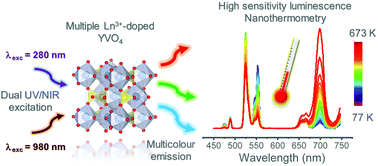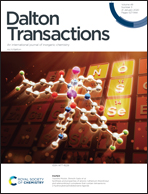High-sensitivity dual UV/NIR-excited luminescence thermometry by rare earth vanadate nanoparticles†
Abstract
High-crystallinity rare earth (RE) vanadate nanoparticles doped with Tm3+, Er3+ or Ho3+ combine multiple emissions in red, green, and blue under dual UV/NIR excitation, promoting high performance self-referenced luminescence thermometry. Due to their very high chemical and thermal stability, these versatile single-phase compositions allow optical thermal sensing from cryogenic (77 K) to moderately high (673 K) temperatures with high reproducibility and low temperature uncertainty. Hence, these nanomaterials operate as optical thermometers in a very broad temperature range (∼600 K), owing to the availability of twelve emission intensity ratios for thermometry. The (Y,Yb,Tm,Er)VO4 powders showed temperature-dependent emission colours from yellow (77 K) to green (333 K) to red (673 K), with one of the highest thermal relative sensitivities reported so far for both upconversion (7.4% K−1) and downshift (2.7% K−1) nanothermometry with inorganic nanoparticles. The stability of the particles also allowed dual luminescence thermometry in aqueous colloids, which showed sensitive and stable thermometric behaviour. In addition, we also discussed the temperature variability against the NIR excitation power in colloids as an additional figure of merit to quantify the reliability of the thermometric response. In summary, our results confirmed that REVO4 with multiple emissions and UV/NIR excitability provide stable, reproducible, and sensitive temperature measurements, giving rise to an optically versatile tool for luminescence nanothermometry.



 Please wait while we load your content...
Please wait while we load your content...